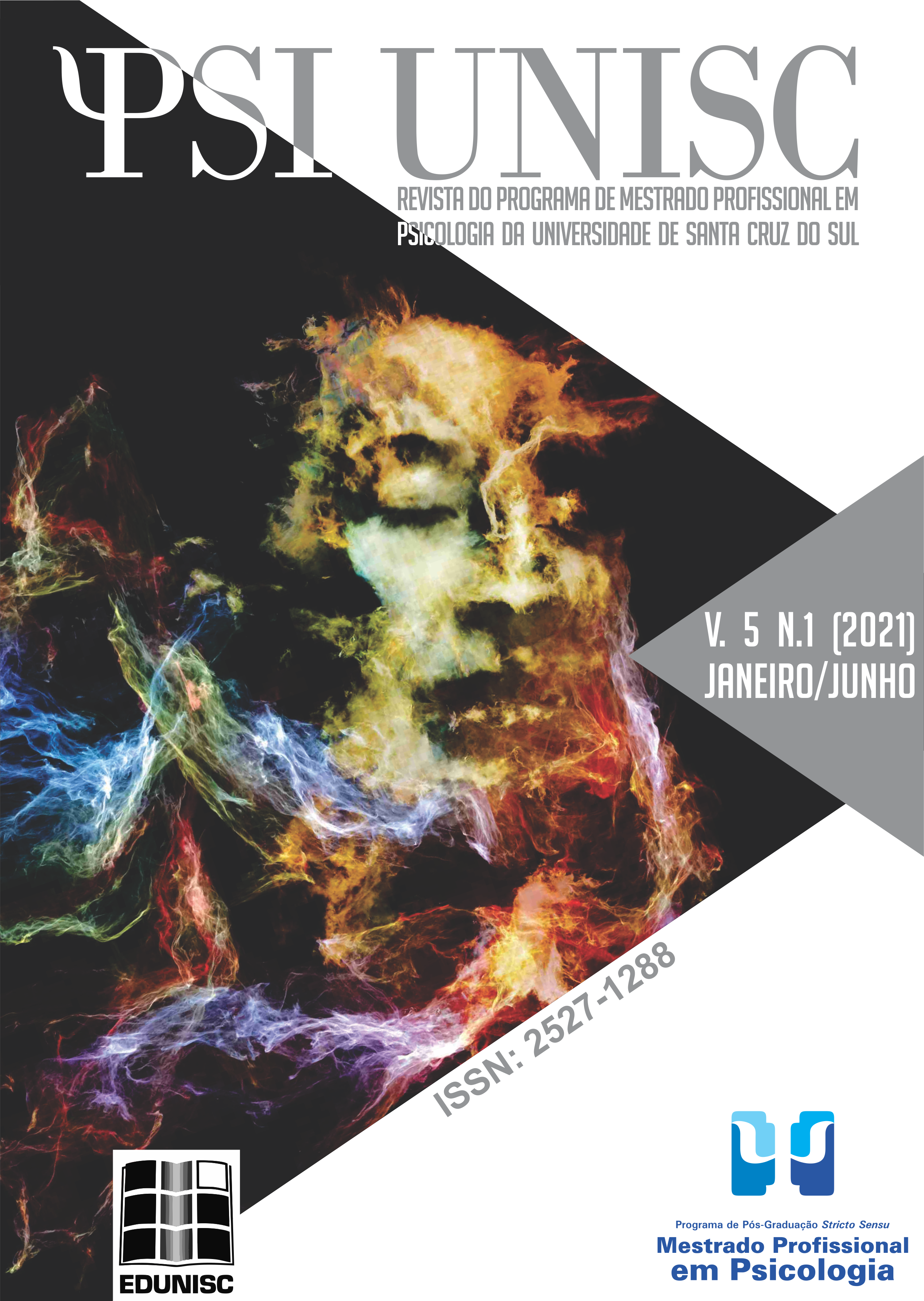Depressive symptoms’ functional analysis in major depressive disorder
DOI:
https://doi.org/10.17058/psiunisc.v5i1.14322Keywords:
Depressive disorder, Major, Depression, Behaviorism.Abstract
Major Depressive Disorder (MDD) causes impairment in all areas of the individual's life, and it will be a more disabling disease by the year 2020 according to the World Health Organization. The objective was to propose an understanding of the depressive symptoms of MDD present in DSM-5 from the perspective of behavior analysis (BA). The depressive symptoms of MDD were mainly due to aversive stimulation, negative reinforcement (avoidance a fugue behaviors), extinction and low positive reinforcement of non-depressive behaviors. A functional analysis of the relationship between the organism and the environment is needed to evaluate depressive symptoms. Relational and cultural factors (e. g., family and social), sex/gender, verbal behavior, and cultural practices must be considered in order to understand variability of depressive symptoms in MDD.Major Depressive Disorder (MDD) causes impairment in all areas of the individual's life, and it will be a more disabling disease by the year 2020 according to the World Health Organization. The objective was to propose an understanding of the depressive symptoms of MDD present in DSM-5 from the perspective of behavior analysis (BA). The depressive symptoms of MDD were mainly due to aversive stimulation, negative reinforcement (avoidance a fugue behaviors), extinction and low positive reinforcement of non-depressive behaviors. A functional analysis of the relationship between the organism and the environment is needed to evaluate depressive symptoms. Relational and cultural factors (e. g., family and social), sex/gender, verbal behavior, and cultural practices must be considered in order to understand variability of depressive symptoms in MDD.Downloads
References
Abreu, P. B. (2006). Terapia analítico-comportamental da depressão: uma antiga ou uma nova ciência aplicada? Revista de Psiquiatria Clínica, 33(6), 322-328. doi: 10.1590/s0101-60832006000600005
American Psychiatric Association [APA]. (2014). Manual Diagnóstico e Estatístico de Transtornos Mentais – DSM-5. Porto Alegre: Artmed.
Azevedo, L. A., Almeida, T. C., & Moreira, A. H. (2009). “O resfriado da psiquiatria”: a depressão sob o ponto de vista analítico-comportamental. Transformações em Psicologia, 2(1), 65-85. Recuperado de http://pepsic.bvsalud.org/scielo.php?script=sci_arttext&pid=S2176-106X2009000100005&lng=pt
Banaco, R. A. (2004). Punição positiva. In: C. N. Abreu & H. J. Guilhardi (Eds.), Terapia Comportamental e Cognitivo-comportamental: práticas clínicas (pp. 61-71). São Paulo: Roca.
Bandini, C. S. M., & Delage, P. E. G. A. (2012). Pensamento e criatividade. In: Hubner, M. M. C., & Moreira, M. B. (Eds.), Temas clássicos da psicologia sob a ótica da Análise do Comportamento (pp. 117-128). Rio de Janeiro: Guanabara Koogan.
Carvalho Neto, M. B. (2002). Análise do comportamento: behaviorismo radical, análise experimental do comportamento e análise aplicada do comportamento. Interação em Psicologia, 6(1), 13-18. doi: 10.5380/psi.v6i1.3188
Catania, A. C. (1999). Aprendizagem: Comportamento, Linguagem e Cognição. Porto Alegre: Artes Médicas Sul.
Cavalcante, S. N. (1997). Notas sobre o fenômeno depressão a partir de uma perspectiva analítico-comportamental. Psicologia: Ciência e Profissão, 17(2), 2-12. doi: 10.1590/s1414-98931997000200002
Correia, K. M. L., & Borloti, E. (2011). Mulher e depressão: uma análise comportamental-contextual. Acta Comportamentalia: Revista Latina de Análisis de Comportamiento, 19(3), 359-373. Recuperado de http://pepsic.bvsalud.org/scielo.php?script=sci_arttext&pid=S0188-81452011000300007&lng=pt&tlng=pt
Darwich, R. A., & Tourinho, E. Z. (2005). Respostas emocionais à luz do modo causal de seleção por consequências. Revista Brasileira de Terapia Comportamental e Cognitiva, 7(1), 107-118. Doi: 10.31505/rbtcc.v7i1.46
Fernandes, C. S., Falcone, E. M. O., & Sardinha, A. (2012). Deficiências em habilidades sociais na depressão: estudo comparativo. Psicologia: Teoria e Prática, 14(1), 183-196. Recuperado de http://pepsic.bvsalud.org/scielo.php?script=sci_arttext&pid=S1516-36872012000100014&lng=pt&tlng=pt
Ferster, C. B. (1973). A functional analysis of depression. American Psychologist, 28(10), 857–870. doi: 10.1037/h0035605
Glenn, S. S. (1988). Contingencies and metacontingencies: Toward a synthesis of behavior analysis and cultural materialism. The Behavior Analyst, 11(2), 161-179. doi: https://doi.org/10.1007/bf03392470
Glenn, S. S. (2015). Comportamento individual, cultura e mudança social. Revista Brasileira de Análise do Comportamento, 11(2), 208-222. doi: 10.18542/rebac.v11i2.4015
Hersen, M., Eisler, R. M., Alford, G. S., & Agras, W. S. (1973). Effects of token economy on neurotic depression: An experimental analysis. Behavior Therapy, 4(3), 392–397. doi: 10.1016/S0005-7894(73)80119-4
Hünziker, M. H. L. (2001). O desamparo aprendido e a análise funcional da depressão. In D. R. Zamignani (Eds.), Sobre Comportamento e Cognição: a aplicação da análise do comportamento e da terapia cognitivo-comportamental no hospital geral e nos transtornos psiquiátricos (V. 3, pp. 145-153). Santo André: ESETec.
Kaplan, K. A., & Harvey, A. G. (2016). Tratamento dos transtornos do sono. In: Barlow, D. H. (Eds.), Manual clínico dos transtornos psicológicos: tratamento passo a passo (pp. 636-664). Porto Alegre: Artmed.
Kupferberg A, Bicks L, Hasler G. (2016). Social functioning in major depressive disorder. Neuroscience & Biobehavioral Reviews (69), 313-332. doi: 10.1016/j.neubiorev.2016.07.002
Martin, G., & Pear, J. (2009). Modificação de Comportamento: o que é e como fazer. São Paulo: Roca.
Moreira, M. B.; Medeiros, C. A. (2007). Princípios básicos de análise do comportamento. Porto Alegre: Artmed.
Morin, C. M., Bootzin, R. R., Buysse, D. J., Edinger, J. D., Espie, C. A., & Lichstein, K. L. (2006). Psychological and behavioral treatment of insomnia: update of the recent evidence (1998–2004). Sleep, 29(11), 1398-1414. doi: 10.1093/sleep/29.11.1398
Moriyama, J. D. S., & Amaral, V. L. A. R. D. (2007). Transtorno dismórfico corporal sob a perspectiva da análise do comportamento. Revista Brasileira de Terapia Comportamental e Cognitiva, 9(1), 11-25. doi: 10.31505/rbtcc.v9i1.143
Organização mundial de saúde [OMS]. (2017). Saúde mental: nova compreensão, nova esperança. Genova: OMS.
Reisinger, J. J. (1972). The treatment of “anxiety-depression” via positive reinforcement and response cost. Journal of Applied Behavior Analysis, 5(2), 125-130. doi: 10.1901/jaba.1972.5-125
Rico, V. V., Golfeto, R., & Hamasaki, E. I. M. (2012). Sentimentos. In: Hubner, M. M. C., & Moreira, M. B. (Eds.), Temas clássicos da psicologia sob a ótica da Análise do Comportamento (pp. 88-99). Rio de Janeiro: Guanabara Koogan.
Sadock, B. J., Sadock, V. A., & Ruiz, P. (2017). Compêndio de Psiquiatria: Ciência do Comportamento e Psiquiatria Clínica (11 ed.). Porto Alegre: Artmed.
Skinner, B. F. (1957/2014). Verbal behavior. BF Skinner Foundation.
Skinner, B. F. (1974/1982). Sobre o behaviorismo. São Paulo: Cultrix.
Skinner, B. F. (1953/2003). Ciência e comportamento humano. São Paulo: Martins Fontes.
Downloads
Published
How to Cite
Issue
Section
License
The submission of originals to this journal implies the transfer, by the authors, of the printed and digital publication rights. The copyrights for the published articles are those of the author, with periodical rights on the first publication. Authors may only use the same results in other publications clearly indicating this journal as the medium of the original publication. Because we are an open access journal, we allow free use of articles in educational and scientific applications provided the source is cited under the Creative Commons CC-BY license.




